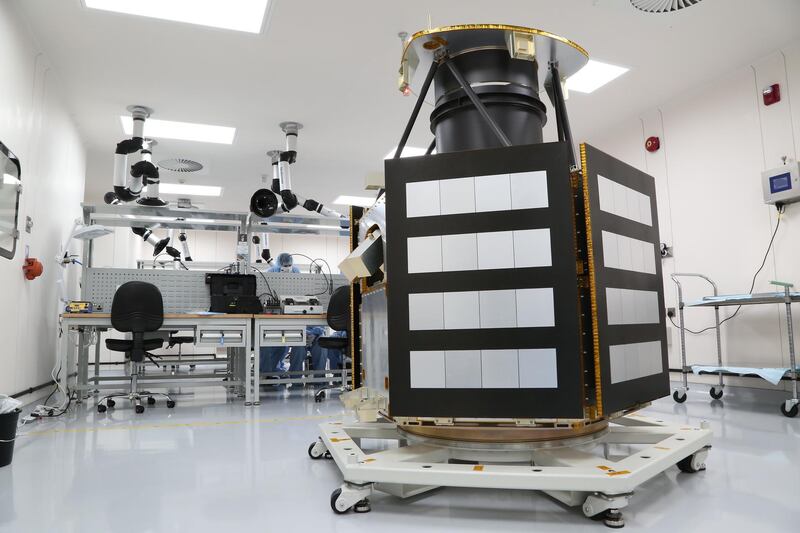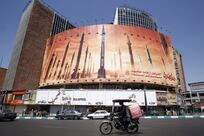The United Arab Emirates is the only Arab country robustly pursuing space diplomacy. This new-age cooperation has taken the form of KhalifaSat – a marvellous feat of engineering and the first Emirati satellite, built with the help of South Korea and scheduled to be launched on Monday from Japan.
As part of the UAE's broader space plan, the first Emirati astronaut will blast into space in April 2019 aboard a spacecraft piloted by the Russia Federal Space Agency, Roscosmos. Shortly after, in 2020, the Emirates Mars Mission's spacecraft will be launched from a Japanese rocket.
The KhalifaSat project falls within the realm of expanding institutionalised channels of consultation that could enhance co-operation in international relations. It is estimated that about 80 countries are now using space, either on their own or in partnership, to further individual or collective interests.
In the earliest examples of space diplomacy, the United States and the erstwhile Soviet Union focused their efforts on convincing others of their capabilities and their utilities. This meant goodwill tours of cosmonauts, astronauts and space hardware.
As part of this effort, Yuri Gagarin travelled the world after his 1961 journey to space. Meanwhile, Nasa and the US State Department teamed up in 1962 to send the Friendship 7 spacecraft on a world tour.
Other prominent examples include the United States using LandSat satellites to deliver spectacular scientific images of the Earth to many countries and helping a Saudi Prince Sultan bin Salman bin Abdulaziz Al Saud become the first Arab in space in 1985. The Soviet Union also flew the Indian cosmonaut Rakesh Sharma to space in 1984.
With Asia entering the fray in recent times, space technology-based foreign assistance is likely to become an increasingly important tool to strengthen international relationships. Most of the Asian satellites are aimed at improving connectivity and the delivery of public services. They are launched by a few countries on behalf of others that lack technological or financial capabilities to do so themselves.
The benefits include paving the way for direct-to-home television, internet connectivity, tele-education, telemedicine and emergency management support during natural disasters. These satellites are also capable of aiding meteorological applications, fishing and agricultural advisory notices, and natural resource mapping.
China, India, Japan and South Korea are the most influential players in this domain. These nations are increasingly using space diplomacy as an out-of-the box foreign policy tool. While China is opening the doors to foreign astronauts, India is offering communication transponders to its neighbours through the South Asian Satellite programme.
These examples show that several different varieties of space diplomacy are at play around the world. First, it is a tool of prestige or soft power, as demonstrated, for example, by the United States and China showcasing their achievements.
Second, it is used as an instrument of foreign assistance, which also provides a significant boost in terms of soft power, as India is attempting to achieve.
Third, it can be targeted at generating support from other countries for the development of a country’s own domestic space programmes, as is evident in the efforts of Russia, Europe, Japan and the UAE.
Fourth, it can provide a way to promote commerce in science and technology. India is pursuing this model of creating new markets for the space industry by developing satellites and ground facilities for emerging countries. Japan, in particular, is seeking to achieve a balance between commerce and its own security interests. China, meanwhile, is keen to use satellite technology to create “a digital Silk Road”.
Finally, space diplomacy is being used as an effort to push for an active role in the governance of space as a shared global commons, dealing with issues such as managing increasing satellite debris and the militarisation of space.
As balance-of-power equations are reconfigured, there is evidence that in the future international political security competition in space may supersede other considerations. The fact that more and more countries are entering the fray means that the scope for co-operative initiatives may be curtailed. For now, however, there are ample notable space-related soft-power developments in Asia that should be celebrated.
Moving ahead, the UAE should consider building on the September 2018 announcement of a new Federal law on the regulation of the space sector, which aims to “open up the space sector to investment, research and partnership building”.
As a result, the UAE has a number of policy options to consider. It could invest directly in space programmes of other countries, and even in the new international private initiatives in the space transport sector. There is also the possibility of becoming a stakeholder in the space service delivery systems of other countries, especially for the benefit of developing nations.
On the other hand, it is possible that the UAE may choose to take the lead in collaborating with one or more Gulf countries to establish a regional space agency to encourage research and regional cooperation. Similarly, it could host a forum of key players in the space exploration domain to avoid non-constructive competition, or arrange a meeting to discuss governance of space as a global commons.
The UAE could even appoint a space ambassador to spearhead the country’s explorations of this new frontier in diplomacy.
Dr N Janardhan is Senior Research Fellow, Gulf-Asia Programme, Emirates Diplomatic Academy. This article is an abridged version of a research paper titled Space Diplomacy in Asia’s Orbit





